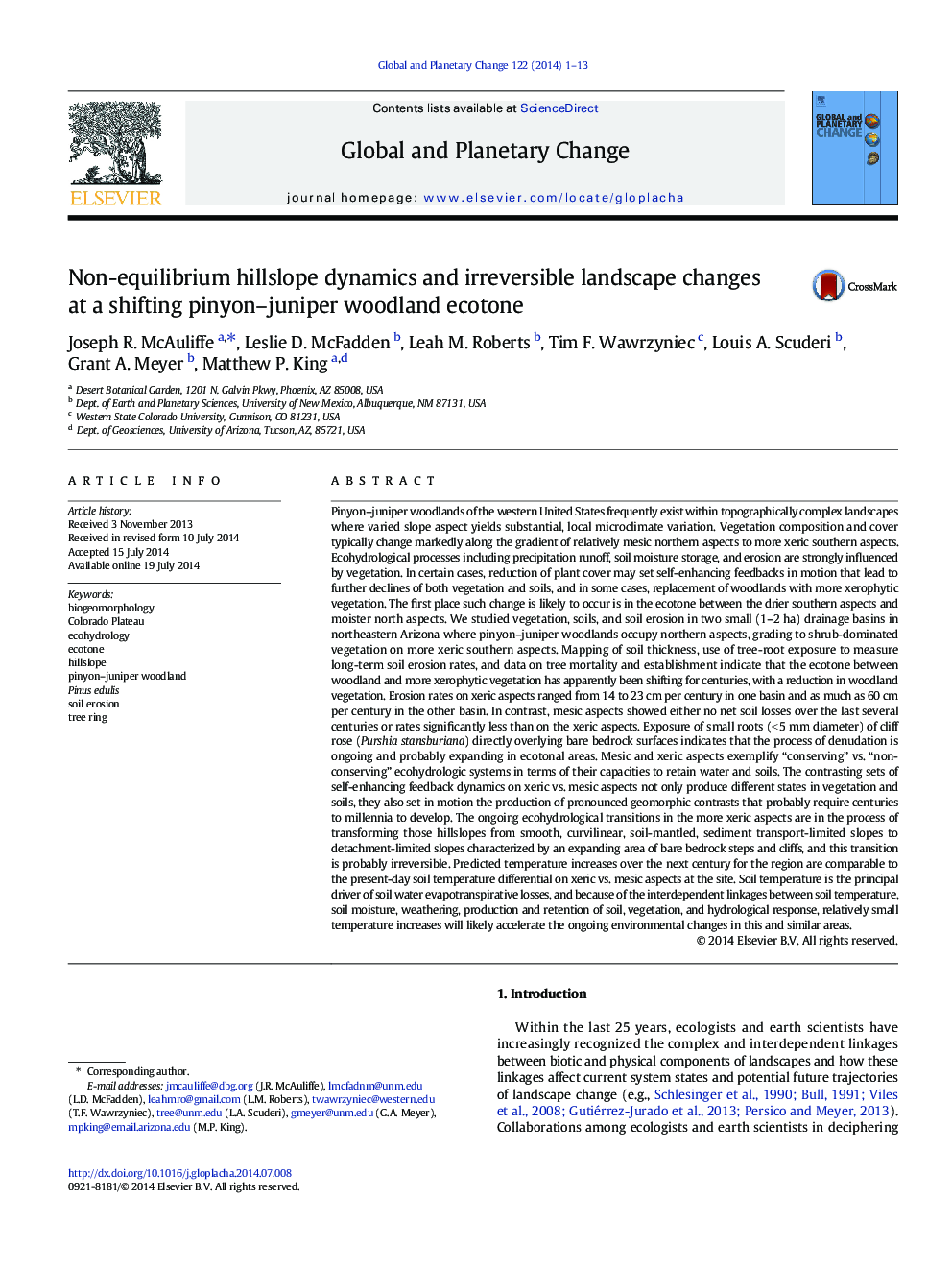| کد مقاله | کد نشریه | سال انتشار | مقاله انگلیسی | نسخه تمام متن |
|---|---|---|---|---|
| 6348169 | 1621659 | 2014 | 13 صفحه PDF | دانلود رایگان |
عنوان انگلیسی مقاله ISI
Non-equilibrium hillslope dynamics and irreversible landscape changes at a shifting pinyon-juniper woodland ecotone
ترجمه فارسی عنوان
دینامیک تلسکوپ غیر قابل تعادل و تغییرات چشمگیر غیر قابل برگشت در یک تغییر اکوئن پلاتینی
دانلود مقاله + سفارش ترجمه
دانلود مقاله ISI انگلیسی
رایگان برای ایرانیان
کلمات کلیدی
موضوعات مرتبط
مهندسی و علوم پایه
علوم زمین و سیارات
فرآیندهای سطح زمین
چکیده انگلیسی
Pinyon-juniper woodlands of the western United States frequently exist within topographically complex landscapes where varied slope aspect yields substantial, local microclimate variation. Vegetation composition and cover typically change markedly along the gradient of relatively mesic northern aspects to more xeric southern aspects. Ecohydrological processes including precipitation runoff, soil moisture storage, and erosion are strongly influenced by vegetation. In certain cases, reduction of plant cover may set self-enhancing feedbacks in motion that lead to further declines of both vegetation and soils, and in some cases, replacement of woodlands with more xerophytic vegetation. The first place such change is likely to occur is in the ecotone between the drier southern aspects and moister north aspects. We studied vegetation, soils, and soil erosion in two small (1-2Â ha) drainage basins in northeastern Arizona where pinyon-juniper woodlands occupy northern aspects, grading to shrub-dominated vegetation on more xeric southern aspects. Mapping of soil thickness, use of tree-root exposure to measure long-term soil erosion rates, and data on tree mortality and establishment indicate that the ecotone between woodland and more xerophytic vegetation has apparently been shifting for centuries, with a reduction in woodland vegetation. Erosion rates on xeric aspects ranged from 14 to 23Â cm per century in one basin and as much as 60Â cm per century in the other basin. In contrast, mesic aspects showed either no net soil losses over the last several centuries or rates significantly less than on the xeric aspects. Exposure of small roots (<Â 5Â mm diameter) of cliff rose (Purshia stansburiana) directly overlying bare bedrock surfaces indicates that the process of denudation is ongoing and probably expanding in ecotonal areas. Mesic and xeric aspects exemplify “conserving” vs. “non-conserving” ecohydrologic systems in terms of their capacities to retain water and soils. The contrasting sets of self-enhancing feedback dynamics on xeric vs. mesic aspects not only produce different states in vegetation and soils, they also set in motion the production of pronounced geomorphic contrasts that probably require centuries to millennia to develop. The ongoing ecohydrological transitions in the more xeric aspects are in the process of transforming those hillslopes from smooth, curvilinear, soil-mantled, sediment transport-limited slopes to detachment-limited slopes characterized by an expanding area of bare bedrock steps and cliffs, and this transition is probably irreversible. Predicted temperature increases over the next century for the region are comparable to the present-day soil temperature differential on xeric vs. mesic aspects at the site. Soil temperature is the principal driver of soil water evapotranspirative losses, and because of the interdependent linkages between soil temperature, soil moisture, weathering, production and retention of soil, vegetation, and hydrological response, relatively small temperature increases will likely accelerate the ongoing environmental changes in this and similar areas.
ناشر
Database: Elsevier - ScienceDirect (ساینس دایرکت)
Journal: Global and Planetary Change - Volume 122, November 2014, Pages 1-13
Journal: Global and Planetary Change - Volume 122, November 2014, Pages 1-13
نویسندگان
Joseph R. McAuliffe, Leslie D. McFadden, Leah M. Roberts, Tim F. Wawrzyniec, Louis A. Scuderi, Grant A. Meyer, Matthew P. King,
